- Courses
- GS Full Course 1 Year
- GS Full Course 2 Year
- GS Full Course 3 Year
- GS Full Course Till Selection
- Online Program
- GS Recorded Course
- NCERT (Recorded 500+ Hours)
- Polity Recorded Course
- Geography Recorded Course
- Economy Recorded Course
- AMAC Recorded Course
- Modern India, Post Independence & World History
- Environment Recoded Course
- Governance Recoded Course
- Science & Tech. Recoded Course
- International Relations and Internal Security Recorded Course
- Disaster Management Module Course
- Ethics Recoded Course
- Essay Recoded Course
- Current Affairs Recoded Course
- CSAT
- 5 LAYERED ARJUNA Mentorship
- Public Administration Optional
- ABOUT US
- OUR TOPPERS
- TEST SERIES
- FREE STUDY MATERIAL
- VIDEOS
- CONTACT US
PLACES IN NEWS 09 DECEMBER 2024
PLACES IN NEWS 09 DECEMBER 2024
09-12-2024
Sathanur Dam
Why in news?
- The sudden release of 1.8 lakh cusecs of water from Sathanur Dam caused severe flooding in Tamil Nadu's Tiruvannamalai, Villupuram, and Cuddalore districts.
- Despite government claims of adherence to standard procedures, many residents reported insufficient or delayed flood warnings.
- Villagers in Puthur Chekkadi, Rayandapuram, and others either received vague alerts or none. They usually relied on neighbours or mosque announcements for updates.
- This has resulted in significant losses, including livestock and other natural resources.
About Sathanur Dam:
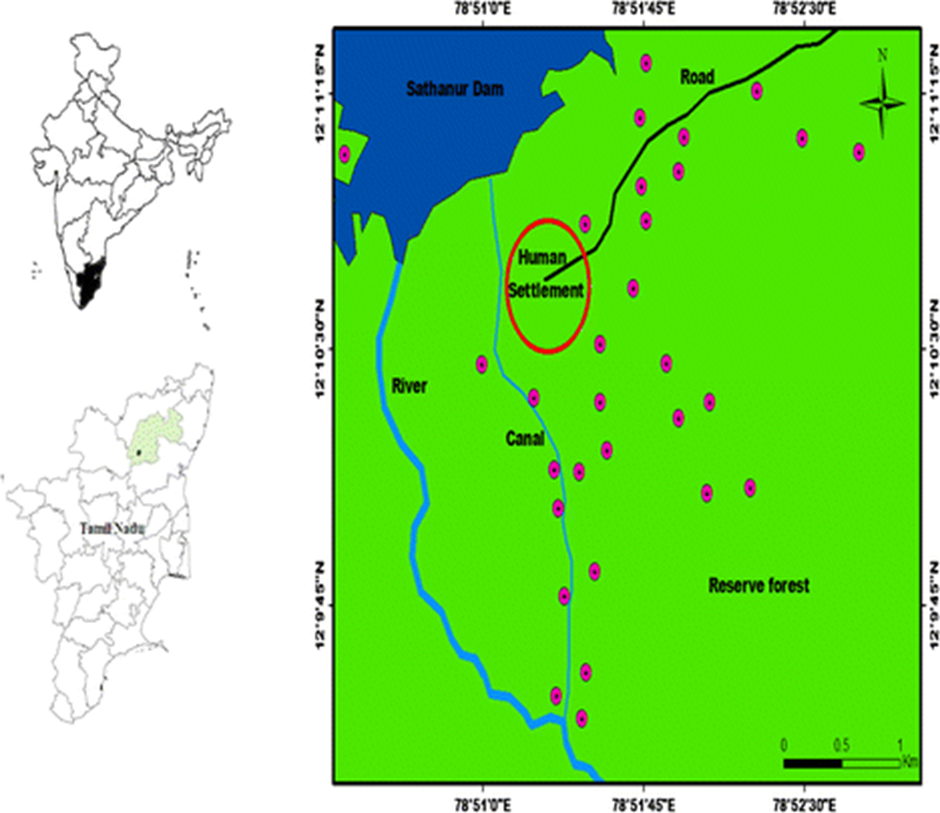
- Sathanur Dam, located in the Tiruvannamalai district of Tamil Nadu, is built across the Thenpennai River, which is one of the state's major rivers.
- It was constructed in 1958, making it among the oldest and most significant dams in Tamil Nadu, designed for irrigation, drinking water supply, and flood control.
- The dam has a maximum storage capacity of 119 feet and serves an extensive command area, supporting agriculture in several districts.
- It features a hydroelectric power station to contribute to renewable energy generation.
- The dam is home to the Sathanur Dam Garden, which is a prominent attraction for tourists that includes lush lawns, fountains, and a crocodile park.
- During monsoons, the dam plays a critical role in managing water flow and preventing floods, though its release can impact downstream regions.
- Its reservoir also supports fisheries and sustains local biodiversity, making it vital to the region's ecosystem and economy.
How Cyclone Fengal has exacerbated the situation?
- Cyclone Fengal brought unprecedented rainfall to Tamil Nadu.
- The heavy downpour caused the Thenpennai River's water levels to rise significantly, which caused the release of 1.8 lakh cusecs of water by dam authorities to prevent structural stress.
- This sudden release triggered flooding in downstream regions, affecting villages in the Tiruvannamalai, Villupuram, and Cuddalore districts.
- The cyclone's intensity overwhelmed the dam's storage and flood management capacities, exposing gaps in early warning systems and disaster preparedness.
Austria
Why in news?
- Austria is facing an issue in forming a government following the September 29 elections, which saw the far-right Freedom Party of Austria (FPO) emerge as the largest party without a majority.
- The FPO, led by Herbert Kickl, has been shunned by all mainstream parties due to its controversial policies, including anti-Muslim rhetoric, Euroscepticism, and pro-Russia stances.
- Austrian President Alexander Van der Bellen bypassed convention by not inviting the FPO to form a government, citing red lines like the country’s European Union membership.
- Instead, Chancellor Karl Nehammer’s People’s Party (OVP) has been tasked with coalition talks, along with other parties.
About Austria:
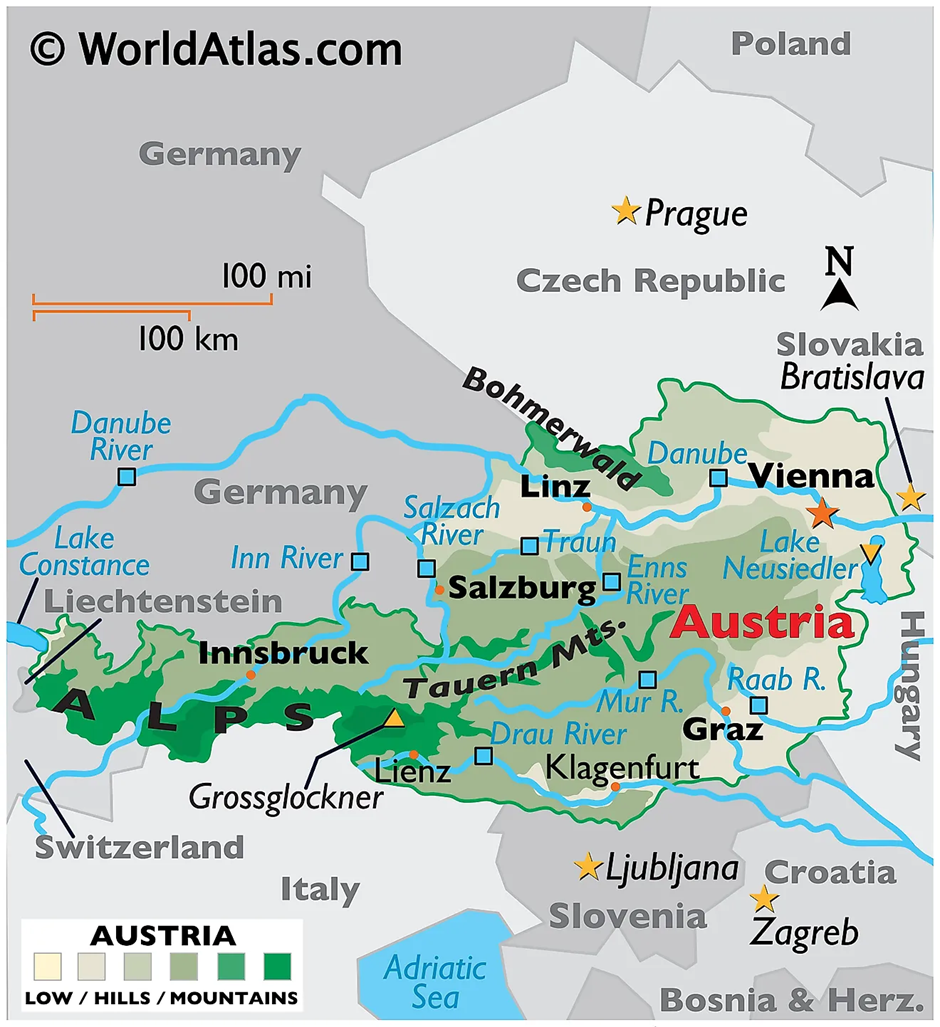
- Geography:
- Austria is a landlocked country in Central Europe known for its stunning alpine landscapes, rich cultural heritage, and strategic location.
- It is bordered by Germany, the Czech Republic, Slovakia, Hungary, Slovenia, Italy, Switzerland, and Liechtenstein and covers approximately 83,879 square kilometres.
- The Alps dominate the western and southern regions, offering breathtaking mountain vistas and skiing opportunities.
- In contrast, the Danube River flows through the northeast, which helps in facilitating trade and connecting Austria to the broader European region.
- Austria experiences a temperate climate, with cold winters and warm summers. Major cities like Vienna (capital of Austria), Salzburg, and Innsbruck are cultural and economic hubs.
- Austria’s location has made it a crossroads for various cultures, influencing its language, cuisine, and architecture.
- It plays a pivotal role in Central European trade and politics, benefiting from its proximity to Western and Eastern Europe.
- Austria’s forested landscapes and lakes also contribute to its ecological and recreational appeal, attracting millions of tourists annually.
- Political History:
- Austria’s modern political history began in the late 19th century as part of the Austro-Hungarian Empire, a dual monarchy established in 1867.
- The empire was characterised by a multi-ethnic entity and faced challenges from rising nationalist movements and economic competition.
- It was defeated in World War I, leading to its disintegration in 1918, and the First Austrian Republic was declared in 1919. The Treaty of Saint-Germain formally separated Austria from Hungary and imposed territorial losses.
- In the 1930s, Austria experienced political instability marked by the rise of authoritarianism under Engelbert Dollfuss and later Kurt Schuschnigg.
- In 1938, Nazi Germany annexed Austria in the Anschluss, incorporating it into the Third Reich. Following World War II, Austria was occupied by Allied forces until 1955, when it regained sovereignty with the Austrian State Treaty and declared permanent neutrality.
- Post-war Austria became a parliamentary democracy and aligned itself with Western Europe during the Cold War.
- It joined the European Union in 1995, strengthening its economic and political ties with Europe.
- Contemporary Austria has faced challenges such as managing migration and the rise of far-right politics, reflecting its evolving political landscape in response to domestic and international pressures.
Afghanistan
Why in news?
- Afghanistan under the Taliban rule has become a dire environment for women, with recent bans on studying medicine and primary education adding to existing restrictions on work, public presence, and personal freedoms.
- Public punishments like executions and amputations have returned, underscoring the regime's brutal enforcement of gender apartheid.
About Afghanistan:
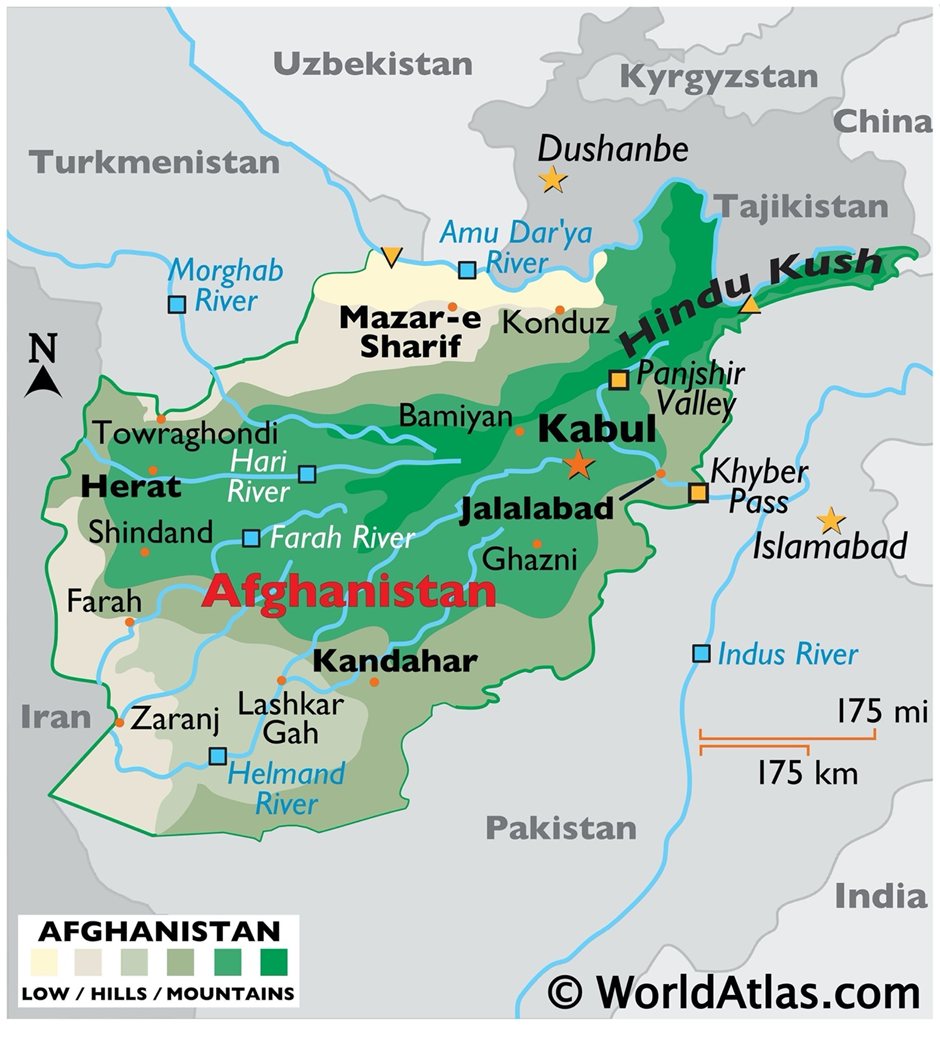
- Afghanistan is a landlocked country in South-Central Asia, covering approximately 652,230 square kilometres.
- It shares borders with Pakistan to the south and east, Iran to the west, Turkmenistan, Uzbekistan, and Tajikistan to the north, and China to the northeast.
- The country's terrain is predominantly mountainous, with the Hindu Kush range dominating the central region. These rugged mountains include peaks over 7,000 meters, with Noshaq being the highest at 7,492 meters.
- The northeastern region connects to the Pamir Mountains, while the west and southwest feature vast desert plains, including the Dasht-e Margo and Registan Desert.
- Afghanistan is home to several river systems, including the Amu Darya, Helmand, Hari, and Kabul rivers, which support agriculture and provide vital water resources in an arid climate.
- The country experiences an arid to semi-arid climate, with hot summers and cold winters, while higher altitudes experience snow and glacial conditions.
- Afghanistan boasts abundant natural resources, including significant deposits of iron ore, copper, gold, lithium, and rare earth elements, critical for modern technology.
- Additionally, it has natural gas and oil reserves and is one of the world's largest sources of lapis lazuli, a semi-precious stone.
- Forests are sparse, primarily found in the eastern provinces, featuring cedar, pine, and oak. Wildlife includes snow leopards, ibex, and Marco Polo sheep.
- Its diverse geography profoundly impacts Afghanistan's culture, economy, and strategic importance, while its natural resources offer vast but underutilised economic potential.
Taliban rule in Afghanistan:
- The Taliban first came to power in 1996, enforcing a strict interpretation of Islamic law and imposing harsh restrictions on women, including banning education, work, and public life.
- In 2001, after the 9/11 attacks, the U.S. led a military intervention that toppled the Taliban regime due to its support for Al-Qaeda.
- The Taliban regained power in 2021 after the U.S. withdrawal, swiftly capturing major cities, including Kabul, and declaring the Islamic Emirate of Afghanistan.
- Under the new rule, the Taliban has reinstated oppressive laws, restricting women’s rights, including banning education, work, and freedom of movement. Public executions, amputations, and other punishments have also returned.
- Despite pledges to form a more inclusive government, the Taliban continues to marginalise ethnic minorities, particularly Hazaras and women, and faces widespread international condemnation.
- The Taliban enforces strict religious codes, curtailing freedom of expression and press while suppressing dissenting views.
Lonar Lake
Why in news?
- The Maharashtra government plans to submit a proposal to the Archaeological Survey of India to include Lonar Lake in Buldhana district as a UNESCO World Heritage Site.
- If successful, Lonar Lake will become India's 41st UNESCO site, alongside the Ajanta and Ellora Caves.
About Lonar Lake:
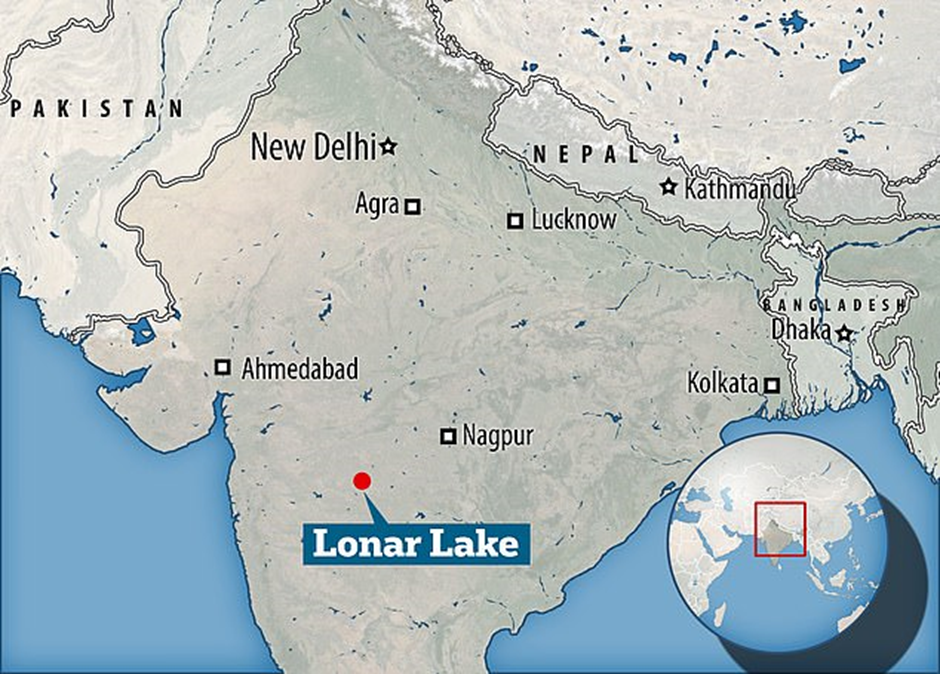
- Lonar Lake is located in Buldhana district, Maharashtra, formed by a meteor impact approximately 50,000 years ago.
- It is the world’s largest basaltic impact crater and one of only four such lakes in the world.
- The other three are Clearwater Lake in Canada, Pingualuit Crater Lake in Canada, and Chesapeake Bay in the United States.
- The lake spans over 113 hectares, with a diameter of more than 1.8 kilometers and a depth of 150 meters.
- Known for its saline-alkaline waters, it supports a unique ecosystem, including various species of flora and fauna.
- The surrounding area is rich in cultural heritage, with over 15 ancient temples, some dating back 1,200 years.
- It is a wildlife sanctuary and was declared a Ramsar site for its ecological significance.
- The site has attracted research from prestigious institutions like the Smithsonian and Geological Society of India.
- Conservation efforts are being made due to rising water levels, which have submerged several temples.
- The site is a growing tourist attraction, with over 4,26,000 domestic visitors annually.
About World heritage sites:
- World Heritage Sites are locations around the world that have been recognised by the United Nations Educational, Scientific and Cultural Organisation (UNESCO) for their cultural, historical, scientific, or natural significance.
- These sites are considered to have outstanding universal value and are protected under international treaties.
- The concept was formalised during the 1972 UNESCO World Heritage Convention, which aims to identify, protect, and preserve sites of exceptional importance for humanity.
- The World Heritage Committee, consisting of representatives from member countries, meets annually to evaluate nominations for new sites. The Committee manages the World Heritage List and provides guidelines for the protection and conservation of these sites.
- Over 1,100 sites are currently inscribed worldwide, including cultural, natural, and mixed properties.
- India has 40 UNESCO World Heritage Sites as of 2024, with sites like the Taj Mahal, Qutub Minar, Red Fort, and Ajanta and Ellora Caves among the most famous.
- India also boasts natural sites such as the Kaziranga National Park and the Sundarbans.
Caspian Sea
Why in news?
- The Caspian Sea is experiencing shrinking water levels due to a combination of human activities and climate change.
- Damming of rivers feeding the sea, over-extraction of water, and rising temperatures have accelerated the decline.
About Caspian Sea:
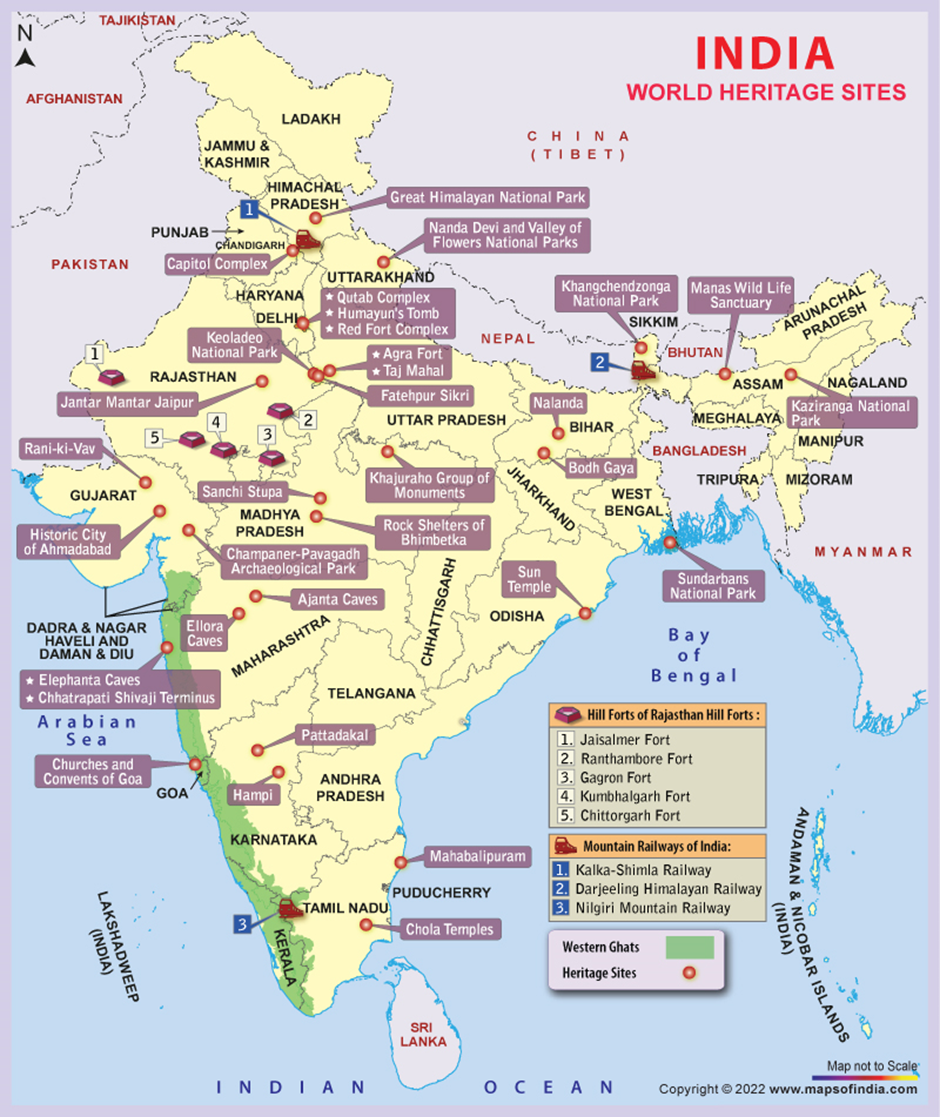
- The Caspian Sea is the world’s largest inland body of water and is often referred to as a lake due to its landlocked nature.
- It spans an area of approximately 371,000 square kilometres and is bordered by five countries: Kazakhstan, Russia, Turkmenistan, Iran, and Azerbaijan.
- The Caspian Sea has a coastline that stretches over 4,000 miles and is known for its significant ecological and economic importance.
- It is a saltwater lake with varying levels of salinity across regions and is home to numerous marine species, including the endangered Caspian seal and wild sturgeon, which provide 90% of the world’s caviar.
- The sea is fed by over 130 rivers, with 80% of its water coming from the Volga River in Russia.
- Its climate is mostly arid, affecting its water balance, which relies on inflow from rivers and evaporation.
- The sea has significant oil and gas reserves, making it strategically important for the bordering countries.
Why Caspian sea is shrinking?
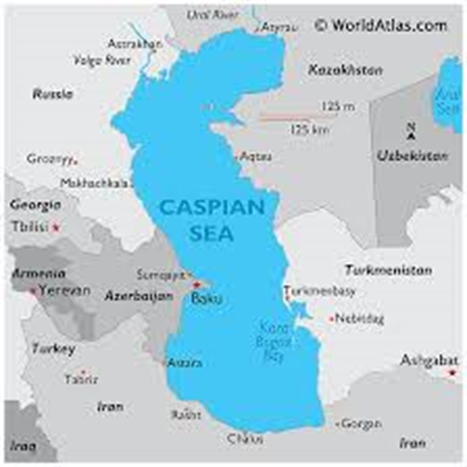
The Caspian Sea is undergoing significant shrinkage due to a combination of human activities and climate change.
- The sea’s water levels have been dropping since the mid-1990s, with an accelerated decline since 2005.
- Over-extraction of water from its rivers, particularly the Volga River, and the construction of dams in Russia have reduced the freshwater input into the Caspian.
- The region’s climate change has increased evaporation rates, which exacerbated the shrinkage.
- As the water recedes, it affects local ecosystems, including endangered species such as the Caspian seal and wild sturgeon.
- The shrinking water levels have led to the loss of critical habitats, reduced fishery yields, and the disappearance of coastal areas that were once vital for shipping and tourism.
- The geopolitical ramifications are also significant, with competing countries relying on the sea’s resources, creating potential conflicts over oil and gas reserves.
- This situation mirrors the tragedy of the Aral Sea, which once spanned Kazakhstan and Uzbekistan but has nearly disappeared due to similar human-driven factors, such as water diversion for irrigation. The Aral Sea’s collapse serves as a dire warning of the consequences of mismanagement and climate change on landlocked bodies of water.
|
UPSC CSE PYQs Q1. Consider the following countries:
Which of the above have borders with Afghanistan? (2022)
Answer: Option C Q2. Which of the following has/have shrunk immensely/dried up in the recent past due to human activities?
|



